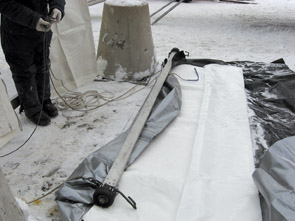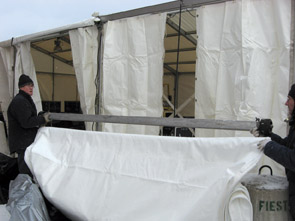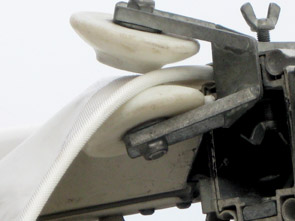
A sensitive pull
By *
Features Business IntelligenceMarket Innovation: A 10 year old concept is finally coming to market.
Fiesta Tents, a designer and manufacturer of tents and tent products in Montreal, Quebec, is now marketing its Fabric Puller, an innovative machine designed to pull tent tops for any and all clearspan structures. This simple piece of machinery not only significantly reduces labour requirements related to pulling tent tops when erecting tent structures, it also dramatically reduces the time needed to perform this task while giving tent erectors full control to avoid tears in the tent fabric.
 |
| Getting the roller kit and fabric ready to pull tops. Préparation de la barre à roulettes et du matériel pour hisser les dessus. |
Alexandre Renaud, from Fiesta Tents, says the product was initially developed 10 years ago and the company has been using it in its own rental division like a ‘Jimmy-rigged’ homemade contraption specifically designed to help its own tent erection crews on site.
“It didn’t have the safeguards for general use to commercialize it, but recently we have negotiated a deal with a winch manufacturer which allowed us to adopt their winch design and modify it slightly for our own application,” explains Renaud, adding that Fiesta has exclusive distribution rights to this winch technology. “Now it has built-in safety features that prevent the winch from slipping so this is something that anybody can use. It’s very simple and it only requires 10 to 15 minutes of training to operate it.”
The general concept of using some sort of mechanical assistance to pull tent tops and sidewalls over framed structures is not new and there are other variations of such tools. Renaud says most companies involved in this business adopt some sort of top pulling technique using various methods such as pulling the fabric with a truck or a forklift.
 |
| Hooking the roller kit to the tent top before inserting it into the keder tracks. Mise en place de l’ensemble de la barre à roulettes au-dessus de la tente avant d’insérer le ‘keder’ dans les rails de l’armature. |
The most significant feature of this device which sets it aside from others is the pulling sensitivity which gives the operator a sense of the resistance offered when the fabric is being pulled into place. This feature allows the operator to stop the process and maintain the top in position while another technician clears any obstructions. This prevents over-stressing the tent tops and ripping the fabric causing expensive damages to equipment. “Other winch systems can’t do that. Its sensitivity is the real genius behind this machine. This device allows the operator to feel if it is jammed or not. The rope is in your hands so you can feel resistance and stop applying power,” he says.
The initial model developed by the company was powered by a two-stroke engine. To avoid emissions and using mixed fuel, the Fabric Puller is now equipped with a four-stroke engine that runs off regular fuel. “The challenge for us was coming up with something that’s functional and practical. This model runs longer and you can use it about 20 to 30 times before needing to re-fuel,” he says.
The Fabric Puller was conceptualized by David Murray, company president and owner, who has been in the tent business since 1977. His business partner and company engineer, Richard Castonguay, collaborated with Murray on the modifications.
 |
| Keder track feeding wheels to help guide the fabric. Roues guides pour aider à guider le matériel. |
Renaud says the product was first presented to the industry at the Mid Atlantic Tent Rental Association (MATRA) Tent Expo in November 2007 where the product was demonstrated on a 50 foot structure. “Most people in the clearspan business know the value of something like this. It’s not expensive and it comes with roller kits to adapt it to any clearspan product out there, as well as any kedered top or sidewall,” he says.
Editor’s note: When a tent top or tent sidewall slides into a frame to create a tight, seamless fit, it is called ‘kedered’. Track tents have kedered tops and kedered sidewalls. Track tents larger than 40 feet are considered to be ‘clearspan’ tents.
While this product comes on the heels of other innovative products, like the company’s Legacy Walkways, it is one of the most interesting product developments since the advent of the stake driver. To the company, however, this Fabric Puller is just another innovative step in its history of evolving its product line. “Maybe to us it’s a simple modification, but for people who make their living from erecting tents it’s a big deal,” says Renaud. -end-
Print this page